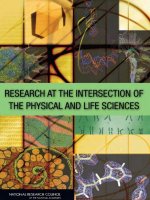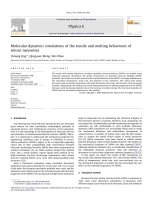Evolution of the Earth and its Atmosphere and its Atmosphere
Bạn đang xem bản rút gọn của tài liệu. Xem và tải ngay bản đầy đủ của tài liệu tại đây (1.12 MB, 18 trang )
Evolution of the Earth
Evolution of the Earth
and its Atmosphere
and its Atmosphere
4.7 billion years ago:
4.7 billion years ago:
♦
The proto-Earth was a loosely-packed ball of “dirt” (primarily
The proto-Earth was a loosely-packed ball of “dirt” (primarily
silicon, iron, nickel and their oxides), surrounded by a thin
silicon, iron, nickel and their oxides), surrounded by a thin
primordial atmosphere of hydrogen and helium (with traces of
primordial atmosphere of hydrogen and helium (with traces of
argon, neon and krypton).
argon, neon and krypton).
4.7 billion years ago – 4.3 billion years ago:
4.7 billion years ago – 4.3 billion years ago:
♦
The planet settled over 400 million years into a densely packed
The planet settled over 400 million years into a densely packed
ball, with a molten core (due to pressure and high levels of
ball, with a molten core (due to pressure and high levels of
radioactivity.
radioactivity.
♦
Most of the hydrogen and helium either “escaped” by
Most of the hydrogen and helium either “escaped” by
absorption of solar radiation or was blown away by the
absorption of solar radiation or was blown away by the
“solar wind”.
“solar wind”.
♦
The atmosphere grew even thinner, consisting solely of trace
The atmosphere grew even thinner, consisting solely of trace
amounts of hydrogen, helium, argon, neon and krypton.
amounts of hydrogen, helium, argon, neon and krypton.
Evolution of the Earth
Evolution of the Earth
and its Atmosphere
and its Atmosphere
4.3 billion years ago – 4.0 billion years ago:
4.3 billion years ago – 4.0 billion years ago:
♦
Through fissures in the Earth’s crust, “volcanic outgassing”
Through fissures in the Earth’s crust, “volcanic outgassing”
spewed vast amounts of hydrogen (H
spewed vast amounts of hydrogen (H
2
2
), nitrogen (N
), nitrogen (N
2
2
),
),
water (H
water (H
2
2
O), carbon monoxide (CO), carbon dioxide (CO
O), carbon monoxide (CO), carbon dioxide (CO
2
2
),
),
ammonia (NH
ammonia (NH
3
3
) and methane (CH
) and methane (CH
4
4
) into the atmosphere.
) into the atmosphere.
♦
Most of the H
Most of the H
2
2
O vapor condensed to form the oceans.
O vapor condensed to form the oceans.
♦
As a result of three key processes (outlined on the next slide),
As a result of three key processes (outlined on the next slide),
the air ended up consisting primarily of N
the air ended up consisting primarily of N
2
2
, CO
, CO
2
2
and CH
and CH
4
4
, with
, with
traces of H
traces of H
2
2
, He, Ar, Ne, Kr, H
, He, Ar, Ne, Kr, H
2
2
O, CO and NH
O, CO and NH
3
3
.
.
♦
There was
There was
still no oxygen
still no oxygen
gas (O
gas (O
2
2
)!
)!
♦
Moreover, since CO
Moreover, since CO
2
2
and CH
and CH
4
4
are “greenhouse” gases, the
are “greenhouse” gases, the
climate grew much warmer, thereby preventing freezing and
climate grew much warmer, thereby preventing freezing and
accelerating surface “weathering”.
accelerating surface “weathering”.
Except for Oxygen, almost all of the Earth’s atmosphere today
Except for Oxygen, almost all of the Earth’s atmosphere today
actually comes from the planet’s interior!
actually comes from the planet’s interior!
Process
Process
“Equation”
“Equation”
Disassociation of
Disassociation of
NH
NH
3
3
2NH
2NH
3
3
+
+
uv
uv
→
→
N
N
2
2
+ 3H
+ 3H
2
2
Conversion of
Conversion of
some
some
H
H
2
2
O and
O and
most
most
CO
CO
H
H
2
2
O + CO +
O + CO +
sunlight
sunlight
→
→
H
H
2
2
+ CO
+ CO
2
2
(As most H
(As most H
2
2
O condensed to create the oceans, rain, erosion
O condensed to create the oceans, rain, erosion
and tides began “weathering” the Earth’s surface.)
and tides began “weathering” the Earth’s surface.)
Carbonate rock formation
Carbonate rock formation
CaO + CO
CaO + CO
2
2
→
→
CaCO
CaCO
3
3
(limestone)
(limestone)
(CO
(CO
2
2
absorption)
absorption)
MgO + CO
MgO + CO
2
2
→
→
MgCO
MgCO
3
3
(dolomite)
(dolomite)
Summary: most H
Summary: most H
2
2
escaped; N
escaped; N
2
2
kept accumulating (since it
kept accumulating (since it
didn’t react with anything else); most H
didn’t react with anything else); most H
2
2
O was condensed or
O was condensed or
converted; most CO was converted; CO
converted; most CO was converted; CO
2
2
accumulated, though
accumulated, though
a lot was absorbed in “weathering”; most NH
a lot was absorbed in “weathering”; most NH
3
3
disassociated;
disassociated;
and CH
and CH
4
4
accumulated (since it didn’t react with anything else
accumulated (since it didn’t react with anything else
at this point
at this point
).
).
Evolution of the Earth
Evolution of the Earth
and its Atmosphere
and its Atmosphere
4.0 billion years ago – 3.8 billion years ago:
4.0 billion years ago – 3.8 billion years ago:
♦
Volcanic outgassing slowed dramatically while carbonate rock
Volcanic outgassing slowed dramatically while carbonate rock
formation increased, thereby lowering CO
formation increased, thereby lowering CO
2
2
levels somewhat.
levels somewhat.
♦
N
N
2
2
and CH
and CH
4
4
continued to accumulate.
continued to accumulate.
♦
The Earth’s surface was still completely unsuitable for
The Earth’s surface was still completely unsuitable for
supporting life, due to the atmosphere’s high methane content
supporting life, due to the atmosphere’s high methane content
and excessive levels of solar ultraviolet radiation.
and excessive levels of solar ultraviolet radiation.
♦
However, a combination of solar ultraviolet radiation, lightning,
However, a combination of solar ultraviolet radiation, lightning,
radioactivity and meteorite bombardment of the surface
radioactivity and meteorite bombardment of the surface
created complex organic molecules (proteins, amino acids,
created complex organic molecules (proteins, amino acids,
maybe even DNA).
maybe even DNA).
♦
Ultimately, this led to the appearance
Ultimately, this led to the appearance
☻
☻
of primitive one-celled
of primitive one-celled
aquatic
aquatic
organisms which could survive in the oceans.
organisms which could survive in the oceans.
Life on Earth had begun, despite its inhospitable atmosphere!
Life on Earth had begun, despite its inhospitable atmosphere!
Evolution of the Earth
Evolution of the Earth
and its Atmosphere
and its Atmosphere
3.8 billion years ago – 2.5 billion years ago:
3.8 billion years ago – 2.5 billion years ago:
♦
Some of the one-celled organisms in the oceans developed the
Some of the one-celled organisms in the oceans developed the
ability to conduct “photosynthesis”:
ability to conduct “photosynthesis”:
Process
Process
“Equation”
“Equation”
Photosynthesis
Photosynthesis
6H
6H
2
2
O + 6CO
O + 6CO
2
2
+
+
sunlight
sunlight
→
→
C
C
6
6
H
H
12
12
O
O
6
6
+ 6O
+ 6O
2
2
(This provided food, in the form of glucose, to these primitive
(This provided food, in the form of glucose, to these primitive
aquatic plants, and very importantly,
aquatic plants, and very importantly,
began the release of
began the release of
oxygen into the atmosphere
oxygen into the atmosphere
!)
!)
♦
By 2.5 billion years ago, atmospheric oxygen accumulated to a
By 2.5 billion years ago, atmospheric oxygen accumulated to a
level of about 1% (by volume).
level of about 1% (by volume).
Evolution of the Earth
Evolution of the Earth
and its Atmosphere
and its Atmosphere
2.5 billion years ago – 600 million years ago:
2.5 billion years ago – 600 million years ago:
♦
Slowly but steadily, the evolutionary process and
Slowly but steadily, the evolutionary process and
photosynthesis continued.
photosynthesis continued.
♦
Multi-celled organisms appeared, and some of these evolved
Multi-celled organisms appeared, and some of these evolved
into soft-bodied worm-like animals with a variety of organs,
into soft-bodied worm-like animals with a variety of organs,
and still later into the first hard-shelled creatures capable of
and still later into the first hard-shelled creatures capable of
leaving fossils.
leaving fossils.
♦
Oxygen continued to accumulate in the atmosphere, reaching
Oxygen continued to accumulate in the atmosphere, reaching
about 10% by volume.
about 10% by volume.
♦
Life above the water was still not possible, due to strong solar
Life above the water was still not possible, due to strong solar
ultraviolet radiation and high levels of methane.
ultraviolet radiation and high levels of methane.
Evolution of the Earth
Evolution of the Earth
and its Atmosphere
and its Atmosphere
600 million years ago – 3 million years ago:
600 million years ago – 3 million years ago:
♦
Volcanic outgassing slowed to a relative trickle, but two more
Volcanic outgassing slowed to a relative trickle, but two more
key processes (outlined on the next slide) completely altered
key processes (outlined on the next slide) completely altered
the atmosphere, enabling plants and animals to leave the
the atmosphere, enabling plants and animals to leave the
oceans, and survive and evolve on land.
oceans, and survive and evolve on land.
♦
Between 450 million years ago and 350 million years ago,
Between 450 million years ago and 350 million years ago,
land plants and amphibian animals began to appear, and
land plants and amphibian animals began to appear, and
oxygen levels approached today’s value of nearly 21% by
oxygen levels approached today’s value of nearly 21% by
volume.
volume.
♦
By the end of this period, the atmosphere contained much
By the end of this period, the atmosphere contained much
less CO
less CO
2
2
than before (280 ppm) and very little CH
than before (280 ppm) and very little CH
4
4
(800 ppb),
(800 ppb),
and the critically important protective ozone layer was in
and the critically important protective ozone layer was in
place.
place.
♦
Plants and animals flourished in continuing diversity, despite
Plants and animals flourished in continuing diversity, despite
occasional mass extinction events.
occasional mass extinction events.
Evolution of the Earth
Evolution of the Earth
and its Atmosphere
and its Atmosphere









